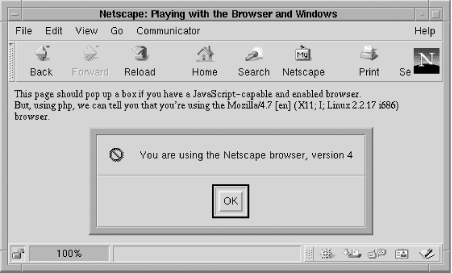Example 7-7 shows how the browser application name and version can be detected with both JavaScript and PHP. The output of the script rendered in a Netscape browser is shown in Figure 7-5. If a JavaScript script requires customization for a particular product, if statements can carry out actions in different ways. Another common approach in JavaScript-intensive web database applications is to write two sites: one that uses Internet Explorer JavaScript and another that uses Netscape Navigator JavaScript.
Which browser is the user using?
<!DOCTYPE HTML PUBLIC
"-//W3C//DTD HTML 4.01 Transitional//EN"
"http://www.w3.org/TR/html401/loose.dtd">
<html>
<head>
<title>Playing with the Browser and Windows</title>
</head>
<body>
<script type="text/javascript">
<!-- Hide the script from old browsers
var version = navigator.appName
var number = parseInt(navigator.appVersion)
alert("You are using the " + version +
" browser, version " + number);
// end the hiding -->
</script>
This page should pop up a box if you have a JavaScript-capable and enabled
browser.
<br>But, using PHP, we can tell you that you're using the
<? printf("%s", $HTTP_USER_AGENT); ?> browser.
</body></html>
Detecting the browser application details using the script in Example 7-7

Comments
The short examples in this section implement common JavaScript web database features, and we recommend that JavaScript be used only for these simple manipulations and the basic validation tasks. Using JavaScript for more complex tasks may reveal annoying differences between browser applications, browser versions, and different platforms. These differences can be compounded by the fact that the web database application developer usually has little control over the standardization of the client JavaScript environment.
Building complex JavaScript adds a thicker client to a web database application.
This tutorial is focused on thin clients, where the majority of the application logic resides in the middle tier. We recommend that JavaScript be kept simple: complex tasks should be left to the middle-tier scripts, and interfaces should still function correctly even if JavaScript is faulty or disabled.
If complex JavaScript is required or desired, make sure it's tested on all the popular platforms with the popular browser products and ver sions.